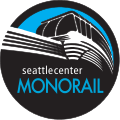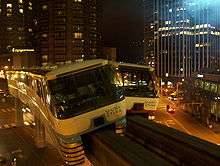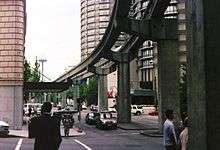Seattle Center Monorail
| Seattle Center Monorail | |||
|---|---|---|---|
 | |||
| Overview | |||
| Type | Straddle-beam monorail | ||
| Status | Operational | ||
| Locale | Downtown Seattle, Washington | ||
| Termini |
Seattle Center (west) Westlake Center (east) | ||
| Stations | 2 | ||
| Daily ridership |
7,000 | ||
| Designated | August 4, 2003[1] | ||
| Operation | |||
| Opened | March 24, 1962 | ||
| Owner | City of Seattle | ||
| Operator(s) | Seattle Monorail Services | ||
| Character | Elevated | ||
| Technical | |||
| Line length | 0.96 mi (1.54 km) | ||
| Electrification | Third rail | ||
| Operating speed | 45 mph (70 km/h) | ||
| |||
The Seattle Center Monorail is an elevated monorail line in Seattle, Washington, that operates along Fifth Avenue between Seattle Center in Lower Queen Anne and Westlake Center in Downtown. Seattle Center Monorail is a self-sufficient public transit system with a top speed of 45 mph (72 km/h). Owned by the City of Seattle, the line has been operated by private contractor Seattle Monorail Services since 1994.[2] It was given historical landmark status by the Seattle Landmarks Preservation Board April 16, 2003.[3]
Creation and route

The monorail, which cost $3.5 million to build, opened on March 24, 1962 for the Century 21 Exposition, a World's Fair held at the current site of Seattle Center. Eight million people rode the monorail during the half year the fair was open; today, annual ridership is around 2 million. The line and its trains were built by Alweg Rapid Transit Systems.[4]
Originally, the south end of the line was a large station over Pine Street at Westlake Avenue that formed a lid over the street and a portion of Westlake Park. In 1988, the station was moved north a block with the construction of the Westlake Center shopping mall on what had been the right-of-way of Westlake Avenue.
The Westlake station of the monorail has an elevator down to the Westlake Station of the Downtown Seattle Transit Tunnel, a stop for the Central Link light rail line, and major Metro bus lines. Westlake Center is also near the southern terminus of the South Lake Union Streetcar and numerous surface bus routes.
At the northern end of the line, the Experience Music Project building was designed so that the monorail passes through it on its way to the terminal.
Operations
The Seattle Center Monorail is operated by a private contractor, Seattle Monorail Services (SMS), which took over operation from the City in June 1994.[2] Operating profits, which can be as much as $750,000 per year, are split between the City and SMS.[2]
Service operates daily, and trains depart every 10 minutes from the station at Seattle Center en route to Westlake Center Mall, at Fifth and Pine Street. Each trip takes two minutes to cover the approximately one-mile route. Every train can carry up to 450 passengers per trip. The monorail provides two-train service during special events and activities, with departures every five minutes or less.
One-way fares are $2.25 for adults, $1.00 for youths aged 5–12, and $1.00 for reduced rate, including seniors citizens 65 years and older, disabled individuals, persons with Medicare cards, and active-duty U.S. military carrying their identification cards. Roundtrip fares are twice the price of a one-way fare, while children four and under ride free.
Technical details
The line consists of two parallel tracks with one train riding each track.
The fleet consists of two trains constructed by Alweg in 1961. These original trains are still in service and have served the line since its opening in 1962.
Each train is powered by four 750 Hp DC Motors running at 700V and typically drawing up to 700 amps. The motors are controlled by a mechanical motor controller that adjusts the position of the motors and number of resistors in the circuit. The motors run into a standard truck differential, with one side blocked off and the other running to the driving wheel, which runs a standard truck tire.
The electric current is drawn from a two-tiered electric rail that is aligned with the side of the track. The top rail is ground, with the live rail suspended beneath it.
The monorail uses dynamic braking for higher speed braking (over 10 mph), and has drum brakes for lower speeds.
Accidents

On July 25, 1971, a brake failure on the red train resulted in it striking the girder at the end of the track in the Seattle Center station, causing injuries to 26 passengers.[5]
On May 31, 2004, a fire broke out on the monorail with 150 people aboard. Five passengers were taken to the hospital with minor injuries.[6]
On November 26, 2005, the two trains clipped one another on a curve, shearing a door off one train. Two people were hospitalized with minor injuries. Poor design and driver error were blamed for the crash;[7][8][9] in 1988, the space between the monorail tracks had been reduced at the southern end of the line to make room for the new Westlake Center, effectively making gauntlet/interlaced track.
Gallery
 Aerial view of monorail in downtown Seattle
Aerial view of monorail in downtown Seattle The monorail tracks with the Space Needle visible in the distance
The monorail tracks with the Space Needle visible in the distance.jpg) The south end of the monorail line, near Westlake Center
The south end of the monorail line, near Westlake Center The monorail passes through the Experience Music Project building
The monorail passes through the Experience Music Project building Cab ride from Westlake Center station to Seattle Center station
Cab ride from Westlake Center station to Seattle Center station
See also
- List of monorail systems
- Seattle Monorail Project (now defunct plan for a new Seattle monorail)
References
- ↑ "City of Seattle Ordinance: 121240". City of Seattle. Retrieved 2013-03-06.
- 1 2 3 Yardley, William (September 25, 2006). "In Seattle, a Dream From the Past Has a Hazy Future". The New York Times. Retrieved 2009-12-13.
- ↑ McRoberts, Patrick. "Space Needle officially becomes a City of Seattle historic landmark on April 19, 1999.". HistoryLink. Retrieved 2006-01-09.
- ↑ A competing proposal came from Greene Monorail Systems. See "Greene Monorail Systems: Theory and Operations" (1958).
- ↑ "Monorail crashes into steel girder at Seattle Center injuring 26, on July 25, 1971.". HistoryLink.org. Retrieved April 12, 2011.
- ↑ "Fire hits monorail at Seattle Center". The Seattle Times. June 1, 2004. Retrieved April 12, 2011.
- ↑ "Monorail trains collide". The Seattle Times. November 27, 2005. Retrieved April 12, 2011.
- ↑ Lindblom, Mike (November 28, 2005). "Monorail collision result of hazard created during 1988 track redesign". Seattle Times.
- ↑ Lange, Larry (January 5, 2006). "Monorail damage more than just dents". Seattle Post-Intelligencer.
External links
| Wikimedia Commons has media related to Seattle Center Monorail. |
- Seattle Center Monorail (current)
- Seattle P-I archives: Seattle Center Monorail
- Seattle page at the Monorail Society
- Unofficial site about the monorail